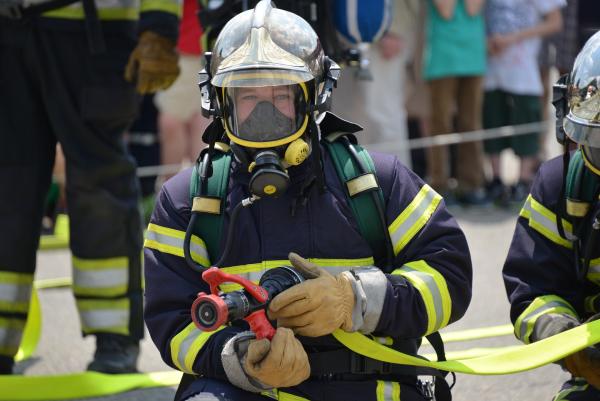This statement is equivalent to being told not to wear your seat belt (which has saved 374,276 lives since 1975) because of the minuscule risk of a seat-belt related injury while driving.
Science, once again, has taken the back seat to media sensationalism. The question about the hazards of firefighting gear came from the wife of a firefighter whose husband was diagnosed with prostate cancer. She contacted a professor who reported “high,” not quantified levels of PFAS in protective gear; the firefighter’s union subsequently began warning their members about the health risks of their protective equipment.
The Real Risks to Firefighters
Firefighting is a dangerous, stressful job. There are physical dangers of firefighting, which include burns, smoke inhalation, and crush injuries from collapsing structures. Heat exhaustion is a constant threat, as well as mental trauma and post-traumatic stress disorder.
The five most significant health risks to firefighters are
- Heart Disease (intense work near fire, exposure to carbon monoxide, high stress)
- Cancer (exposure to toxic chemicals)
- Respiratory Disease (chemical exposures can cause lung damage)
- Hepatitis B and C (as first responders, contact with blood contaminated with hepatitis B and C viruses)
- Mental health (high stress, mental trauma)
The Real Cancer Risk
According to the National Institute for Occupational Safety and Health, firefighters are more than twice as likely to be diagnosed with cancer than people in other jobs. But exposure to carcinogens comes not from their protective gear but the chemicals in the smoke of residential and commercial fires.
A wide range of additional chemicals have been detected in smoke; in a study of nine fires, 144 volatile organic chemicals were identified; another analysis of 100 fires detected 70 different chemicals. Many of these chemicals have been shown to cause cancer in animals (and potentially in humans).
Here is an abbreviated list of those carcinogenic chemicals in smoke from residential and commercial fires:
- Arsenic
- Asbestos
- Benzene
- Cadmium
- Diesel engine exhaust
- Dioxin
- Formaldehyde
- Pentachlorophenol
- Radionuclides
- Creosote
- Polycyclic Aromatic Hydrocarbons
“The Dose Makes the Poison”
This is particularly relevant because firefighters are routinely exposed to high levels of chemicals. Occupational controls in the U.S. over the last 50 years have resulted in highly reduced exposures to toxic chemicals for many workers. One would think that would also be the case for firefighting.
I was surprised to learn that this was not the case. Firefighters work in uncontrolled, hazardous environments; today’s smoke contains more chemicals than in the past due to the increased number of synthetic products used in furniture in homes and offices.
Personal protective equipment (PPE) does not completely eliminate exposure. Particularly in firefighting, where exposure levels are very high, and firefighters often take off their PPE after the initial firefighting phase. However, many carcinogens are still present in the air. Exposure occurs primarily by inhalation but can also occur through skin absorption, and high temperatures experienced by firefighters increase the absorption through the skin.
And then there are firehouses. One study reported high levels of diesel particulate matter and polycyclic aromatic hydrocarbons, known human carcinogens, in fire stations, where firefighters spend their time awaiting a call. The high levels were found primarily in the rest areas and kitchens of the fire stations, which are often adjoined to the truck bay.
“PFAS cause cancer.”
As I wrote about in a previous article, PFAS is a textbook example of when misinformation gets repeated enough, it becomes mistaken for the truth, not just by the uninformed public but by scientists who should know better
The scientific data does not support this statement.
PFAS are one of the few chemicals where there is more data in humans than in animals. Two of these compounds, perfluorooctanoate (PFOA) and perfluorooctanesulfonate (PFOS), have been studied extensively for their association with cancer.
Studies are divided as follows:
- Occupational: Studies that examine cancer deaths in workers exposed to PFAS and compare the death rates with either nonexposed workers or members of the community. These studies are considered the best evidence because they usually involve a large number of workers exposed to relatively high, defined levels of PFAS over long periods.
- Community: Studies that compare cancer rates in a population exposed to PFAS (usually by drinking water) with an unexposed population. Studies may use data on PFAS in blood or from models to determine exposure.
- Case-control: Studies that examine PFAS blood levels in cases (people with a specific type of cancer) and compare the blood levels to controls (people without cancer).
Studies can either show no association (NA) between the cancer rates and PFAS; a positive association (PA), meaning that PFAS are associated with an increased risk of cancer; or an inverse association (IA), meaning that PFAS are associated with a reduced risk of cancer.
Here is a summary of the Agency for Toxic Substances and Disease Registry report on PFOA and cancer:
 Most of the studies found no association between exposure to PFOA and cancer. In the six occupational studies, the “best evidence” studies, no association was reported for all cancer deaths, pancreatic, liver, respiratory tract, and breast. Positive results were found in one of six studies of kidney cancer and two of six studies for prostate cancer. One of six bladder cancer studies noted an inverse association, where PFOA was “protective” of cancer.
Most of the studies found no association between exposure to PFOA and cancer. In the six occupational studies, the “best evidence” studies, no association was reported for all cancer deaths, pancreatic, liver, respiratory tract, and breast. Positive results were found in one of six studies of kidney cancer and two of six studies for prostate cancer. One of six bladder cancer studies noted an inverse association, where PFOA was “protective” of cancer.
It is interesting to consider the inverse associations found in several studies. One study speculated that PFOAs' potent anti-inflammatory effects on our physiology could also lead to anti-cancer impacts.
In 2016 the EPA concluded that there is suggestive evidence of the carcinogenic potential of PFOA and PFOS in humans. In 2017 IARC concluded that PFOA is possibly carcinogenic to humans. How could they reach these conclusions based on the available data? The answer is that agencies do not examine the totality of the data; instead, they pull out the positive studies and use these as the basis for their conclusions. The studies that show either no association or an inverse association do not factor into their conclusions.
It is very clear that the elevated cancer risk faced by firefighters is not related to PFAS. We owe a great debt of gratitude to our nation’s firefighters who risk their lives to ensure our safety. They are being seriously misled by their union, which tells them their protective gear represents a health risk. Any risk from the PFAS in their equipment is minuscule compared to the risk they face by not wearing their gear to protect them from the real dangers of firefighting.
[1] A positive association was only seen in subjects with a hereditary risk of prostate cancer and blood levels of PFOA above the median




